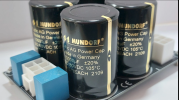JeremyFife
Major Contributor
Hi, can you or someone explain this for me - interested in having a future amp with enough headroom, and also in just understanding this ...So Amir, tell me why this test makes any sense, other than presenting the best figures the "amplifier" is capable of by deliberately running at the lowest gain.
11dB with even your 5V source at full blast output knobbles the output to 39 Watts at 8 ohms.
13dB with your 5V source at full blast output knobbles the output to 62 Watts at 8 ohms.
What exactly are people buying a power amplifier for again? (that was a good pun- for a gain)
Based on your power output graph, it achieves 210W@8R at the knee. That's 41V RMS. So it would need 18dB+ for your 5V source, 20dB+ for a 4V source and 26dB+ for a 2V RCA source. And you tested at 11dB and 13dB...
There's a chart in the review - "Power vs Distortion @ 8 Ohms, both channels driven". Power 'at the knee' is 210W tested at 16dB gain.
Does that say that the input voltage had to have been higher than 5V in order to reach that power output?
Is there somewhere that the input voltage for these tests is specified, or do I just have to learn some maths to be able to read them?
I'd assumed that the 'standard' 4V for balanced (2V for single-ended) would be used.
Thanks


 Processors only, but how many users figured that one out? To IOM's credit, at least they aren't doing that. And it's also fair that this is not just their issue. Hypex is ultimately behind all of these "module in a box" kits that boast unrealistically good SNR by permitting all sorts of oddball gain structures outside of the 28+dB standard, including their default implementation.
Processors only, but how many users figured that one out? To IOM's credit, at least they aren't doing that. And it's also fair that this is not just their issue. Hypex is ultimately behind all of these "module in a box" kits that boast unrealistically good SNR by permitting all sorts of oddball gain structures outside of the 28+dB standard, including their default implementation.